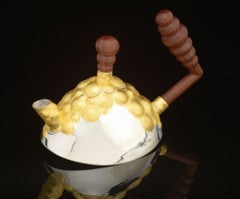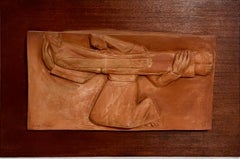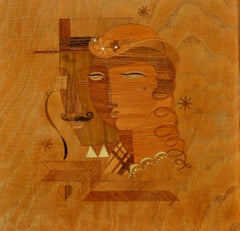Rosewood Figurative Sculptures
to
1
Overall Width
to
Overall Height
to
1
1
1
1
1
1
6,869
147
135
21
17
1
Style: Art Deco
Medium: Rosewood
Golden Botrus Teapot
Located in Kansas City, MO
Artist : Genevieve E. Flynn
Title : Golden Botrus Teapot
Materials : Sterling Silver, Rosewood
Date : 2016
Dimensions : 4.5 x 4 x 4.25 in.
Description : This Saul Bell International Award finalist teapot was inspired from Flynn's love of mineral specimens with botryoidal crystal structures as a young girl. The body was raised from a single sheet of sterling silver, using chasing and repousse techniques. 23 1/2 karat gold leaf is applied over the surface of the "bumps." The handle is made of Pau Rosewood.
ONE OF A KIND.
Award winning silversmith, Genevieve Flynn, has been working in precious metals for 44 years creating hollow-ware and art jewelry family heirlooms. Flynn has been invited to create numerous private commissions, including an intricately chased and engraved hand mirror that was presented to music industry personality, Paula Abdul and a commemorative 1985 World Series pin for the late Ewing Kauffman, then owner of the Kansas City Royals and Marion Laboratories.
contemporary art, ceramics, contemporary ceramics, contemporary fine art, ceramic artists, sculpture, contemporary sculpture, jewelry, contemporary jewelry, jewelry art, Margaret De Patta, René Lalique, Bruce Metcalf, fine art jewelry, Suzanne Belperron, Stanley Lechtzin, Art Smith, Margret Craver...
Category
2010s Art Deco Rosewood Figurative Sculptures
Materials
Silver
Price Upon Request
Related Items
Large George Aarons Terracotta Sculpture Relief Art Deco Plaque WPA Artist
Located in Surfside, FL
Two Figures (Mother and son)
9" x 17" terracotta sculpture, signed lower left mounted to wood panel, 15 1/2" x 23 1/2"
George Aarons (born Gregory Podubisky, in St. Petersburg, Russ...
Category
20th Century Art Deco Rosewood Figurative Sculptures
Materials
Wood, Terracotta
$2,200
H 15.5 in W 23.5 in D 1 in
Les Amie
By Pierre Lardin
Located in West Hollywood, CA
Presenting an original inlaid marquetry wood tray/sculpture by French artist Pierre Lardin.
Pierre Lardin executed his work in wood, creating ...
Category
1920s Art Deco Rosewood Figurative Sculptures
Materials
Wood
Czech Art Deco Carved Natural Resin Cubist Owl Bird Sculpture Joseph Martinek
Located in Surfside, FL
American sculptor Joseph Martinek was born in Chicago in 1915. He was a second generation apprentice to Auguste Rodin. He studied sculpture at the State Industrial School of Art, Pra...
Category
20th Century Art Deco Rosewood Figurative Sculptures
Materials
Resin, Wood
$1,200
H 9 in W 4 in D 6 in
Panthers in the Jungle Art Deco Carved Gilt Wood Panel by N. R. Brunet
Located in Atlanta, GA
Engraved Art Deco Panther Panel by N.R. Brunet (20th Century, France)
A striking and seldom-seen example of Art Deco artistry, this richly engraved wood panel by French sculptor N.R...
Category
1930s Art Deco Rosewood Figurative Sculptures
Materials
Wood
$4,500
H 20.88 in W 27.57 in D 2 in
Plaster Sculpture Relief Art Deco Plaque WPA Artist Peace Swords to Ploughshares
Located in Surfside, FL
Size includes wood mounting.
George Aarons (born Gregory Podubisky, in St. Petersburg, Russia, 1896 - died in Gloucester, Massachusetts 1980) was a distinguished sculptor who lived ...
Category
20th Century Art Deco Rosewood Figurative Sculptures
Materials
Plaster, Wood
$1,100
H 8 in W 10 in D 1 in
Cuban Master Florencio Gelabert Sculpture Large Wood Carving Bust Man Portrait
Located in Surfside, FL
Florencio Gelabert Y Perez (Cuban, 1904-1995)
Hand carved, signed; 1979
Materials: Cuban wood (mahogany?)
Dimensions 23 X 4 X 4 inches
Label affixed to underside: National Registry of Cultural Assets of the Republic of Cuba Ministry of Culture.
Provenance: Art Master Collection, Miami, Florida.
Florencio Gelabert, with a style reminiscent of Art Deco and Art Nouveau in a Latin American Expressionist stylization. Carved wood sculpture. Depicts a modernist stylized form of a man in a streamline moderne style.
José Florencio Gelabert Pérez (Caibarien, 1904 - Havana, 1995) Cuban musician, sculptor, draftsman and teacher. He graduated from the San Alejandro National Academy of Fine Arts in 1934. He received numerous awards, mentions and recognitions in Fine Arts Halls and Circles. His works are in the permanent collection of the National Museum of Fine Arts. Florencio Gelabert is a renowned sculptor, who made more than twenty solo exhibitions beginning in 1929, several in the National Museum of Fine Arts, and participated in more than thirty collectives in Cuba, Spain and Brazil, the latter in the Sao Paulo Biennial. he traveled from Caibarién to Santa Clara in 1928 to audition to enter the famous San Alejandro Fine Arts School in Havana. He obtained one of the five vacancies. Already in the Cuban capital, he combined fine arts and music. When he graduated, he became a professor in San Alejandro and the academy’s principal in 1960.
With a calling common to wood sculptors –which began with his primary school carving carpentry classes and the active life of his home town’s shipyards, his chisels and gouges feverishly turned mahogany, “ácana” and ebony into female heads with black African features dating back to 1930.
In 1938 he used his savings to explore Europe: France (Paris, Marseilles), Italy (Naples, Rome, Florence, and Venice), Belgium (Malina). His encounter with the works by Aristide Maillol, Auguste Rodin, Ossip Zadkine, Constantin Brancusi and even with Wifredo Lam, who was also born in another Cuban coastal area, Sagua la Grande, and his encounter with the nude marble David sculpture...
Category
1970s Art Deco Rosewood Figurative Sculptures
Materials
Wood
$4,500
H 23 in W 4 in D 4 in
Woman, Black, Abstract, Twist, Dance, Gown, Art Deco, Garden, By Commission
Located in Nantucket, MA
Summertime Lady is back to the gallery on consignment. Outstanding focal point for front entry of your home or garden. Flowing curves, elongated form, definitive gaze and the ultimat...
Category
Early 2000s Art Deco Rosewood Figurative Sculptures
Materials
Bronze
$65,000
H 78 in W 20 in D 20 in
Art Deco Venetian Mask Handcarved Wood Panel Wall Sculpture
Located in Atlanta, GA
This superb French Art Deco wooden panel or wall-mounted sculpture features a spectacular Venetian mask and was hand-crafted in the 1930s. The sculpted panel boasts finely detailed c...
Category
1930s Art Deco Rosewood Figurative Sculptures
Materials
Wood
$2,800
H 25.75 in W 19.13 in D 2.75 in
David Hostetler Female Figurative Sculpture BMW Car Paint Art Deco Commission
Located in Nantucket, MA
By Commission. Casting and custom paint will take approximately 4 months. I have to get in line with my paint expert. Cape Lady is a polished bronze casting painted with Glasurit, a hand sprayed car paint. It is BMW white and BMW black. It is a limited edition of 15 with 2 artist proofs. The current edition available would be 6/15. It was cast from an original wood carving by David Hostetler...
Category
2010s Art Deco Rosewood Figurative Sculptures
Materials
Bronze
Demetre Chiparus Egyptian Dancer
Located in Miami, FL
Demetre Chiparus
Egyptian Dancer, ca. 1920
Bronze, enamel, gilt metal, and marble
29 in
Signed to base 'Chiparus'
Category
1920s Art Deco Rosewood Figurative Sculptures
Materials
Bronze
Oriental Dancer
Located in Miami, FL
Oriental Dancer
Cold-painted Bronze Figure, circa 1925
on a shaped marble plinth inset with bronze medallions
15 in high, signed to base 'Chiparus'
Demetre Chiparus was a Romanian s...
Category
1920s Art Deco Rosewood Figurative Sculptures
Materials
Bronze
French Art Deco Walnut Sculpture of a Nude Woman, circa 1920
Located in Rochester, NY
Exceptional and expressively carved solid walnut near life Size statue of nude woman raised on attached fluted column pedestal base in overall beautifully aged original rich surface ...
Category
Early 20th Century Art Deco Rosewood Figurative Sculptures
Materials
Wood, Walnut
$6,800
H 61 in W 15 in D 15 in
Rosewood figurative sculptures for sale on 1stDibs.
Find a wide variety of authentic Rosewood figurative sculptures available on 1stDibs. While artists have worked in this medium across a range of time periods, art made with this material during the 21st Century is especially popular. There are many well-known artists whose body of work includes ceramic sculptures. Popular artists on 1stDibs associated with pieces like this include and Loren Eiferman. Frequently made by artists working in the Abstract, Art Deco, all of these pieces for sale are unique and many will draw the attention of guests in your home. Not every interior allows for large Rosewood figurative sculptures, so small editions measuring 0.4 inches across are also available


